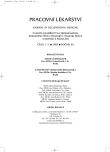-
Medical journals
- Career
Foramen Ovale Patent and Diving
Authors: R. Pudil 1; P. Macura 2; J. Reitinger 3
Authors‘ workplace: I. interní klinika LF UK a FN, Hradec Králové, přednosta Prof. MUDr. Jan Vojáček, DrSc. 1; Ambulance potápěčské medicíny, Hradec Králové 2; Dětská klinika LF UP a FN, Olomouc, přednosta Prof. MUDr. Vladimír Mihál, CSc. 3
Published in: Pracov. Lék., 59, 2007, No. 1-2, s. 60-62.
Category: Review article
Overview
Patent foramen ovale is experiencing much clinical interest as a congenital cardiac lesion that persists up to adulthood. It is a risk factor for several serious clinical syndromes, including decompression sickness in divers. This paper reviews current knowledge of this interesting lesion concerning scuba diving, summarizes diagnostic and therapeutic directions, and recommendation with the aim to minimalize its impact.
Key words:
foramen ovale patent, decompression, diving, diagnostics, therapy, recommendations
Sources
1. WILMHURST, P. T., ELIS, B. G., JENKINS, B. S. Paradoxical gas embolism in scuba diver with an atrial septa defect. Br. Med. J. 1986, 293, s. 1277.
2. HARA, H., VIRMANI, R., LADISH, E. et al. Patent foramen ovale: Current pathology, pathophysiology, and clinical status. J. Am. Coll. Cardiol., 2005, 46, s. 1768–1776.
3. TORTI, S. R., BILLINGER, M., SCHWERTZMANN, M. et al. Risk of decompression illness among 230 divers in relation to the presence and size of patent foramen ovale. Eur. Heart J., 2004; 25, s. 1014–1020.
4. SCHWERTZMANN, M., SEILER, CH., LIPP, E. et al. Relation between directly detected patent foramen ovale and ischemic brain lesions in sport divers. Ann. Intern. Med., 2001, 134, s. 21–24.
5. GERMONPRE, P., HASTIR, F., DENDALE, P., MARRONI, A., NGUYEN, A. F., BALESTRA, C. Evidence for increasing patency of foramen ovale in divers. Am. J. Cardiol., 2005, 95, s. 912–915.
6. CARTONI, D., DE CASTRO, S., VALENTE, G. et al. Identification od professional scuba divers with patent foramen ovale at risk for decompression illness. Am. J. Cardiol., 2004, 94, s. 270–273.
7. WALSH, K. P., WILMHURST, P., MORRISON, W. Trans - catheter closure of patent foramen ovale using the Amplatzer septal occluder to prevent recurrence of neurological decompression illness in divers. Heart, 1999, 81, s. 257–261.
8. LANDZBERG, M. J., KHAIRY, P. Indications for the closure of patent foramen ovale. Heart, 2004, 90, s. 219–224.
9. Flachskampf, F., Daniel, W. Closure of patent foramen ovale: is the case really as well? Heart, 2005, 91, s. 449–450.
10. BENNETT, P., CRONJÉ, F., CAMPBELL, E. Assessment of Diving medical fitness for scuba divers and instructors. Flagstaff : Best Publishing Company 2006, 241 s.
11. MARTIN, L. Diving, patent foramen ovale, brain lesions. Ann. Intern. Med., 2001, 135, s. 928.
12. BOLLEN, A. M. Diving, patent foramen ovale, and brain lesions. Ann. Intern. Med., 2001, 135, s. 928–929.
Labels
Hygiene and epidemiology Hyperbaric medicine Occupational medicine
Article was published inOccupational Medicine

2007 Issue 1-2-
All articles in this issue
- Hyperbaric Oxygenotherapy in Treatment of Children with Neuroblastoma of Highest Risk: Experience in 1997–2000
- Hyperbaric Oxygenotherapy in Traumatology: Therapeutic Results in 2005
- Contribution of Hyperbaric Oxygenotherapy in Comprehensive Therapy of Various Etiology Hypoxic Brain Affections in Children and Adults
- Monitoring of Heart Rate during the Training of Divers
- The Beginning of Hyperbaric Medicine and Oxygenotherapy Specialization in the Czech Republic and its Role in Current Human Medicine
- Hyperbaric Oxygen and Diabetic Foot
- Problem of Sudeck Syndrome
- Transcutaneous Oximetry
- Importance of Hyperbaric Oxygenotherapy in Treatment of Not Healing Defects
- Medical Aspects of Diving
- Medical Examinations of Divers
- Foramen Ovale Patent and Diving
- Occupational Medicine
- Journal archive
- Current issue
- Online only
- About the journal
Most read in this issue- Problem of Sudeck Syndrome
- Contribution of Hyperbaric Oxygenotherapy in Comprehensive Therapy of Various Etiology Hypoxic Brain Affections in Children and Adults
- Medical Examinations of Divers
- Transcutaneous Oximetry
Login#ADS_BOTTOM_SCRIPTS#Forgotten passwordEnter the email address that you registered with. We will send you instructions on how to set a new password.
- Career

